Welcome to the Monkey House
[DVD]
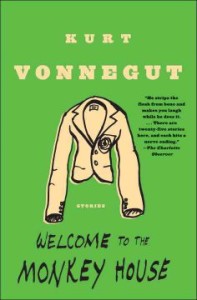
view/request
Selections from Kurt Vonnegut Jr.’s Welcome to the Monkey House, an anthology of shorter fiction, appeared on the Showtime channel in the early 1990’s. The series was on the air for a brief time, but all of the episodes exist on a dvd that we’ve just received from the Pleasant St. Video collection.
Welcome to the Monkey House is fascinating from the outset; the author makes an on camera introduction to the episodes. His opening dialog is the only instance of seeing him on film/tape that I can recall (until this moment, I’ve used my imagination to estimate his mannerisms via book jacket photographs!).
The stories and the overall feel of the series strike a kinship with David Lynch and Mark Frost’s Twin Peaks. Both idiosyncratic television programs were on the air around the same time, draw from 1950’s style and also deal with the abnormal. A mysterious double life, a sadistic battle of wits involving humans as chess pieces, a woman’s obsession with home design catalogs and a child’s eventful night without a babysitter all feature in Welcome to the Monkey House.
Vonnegut has always struck me as someone who has the ability of skillfully introducing science fiction elements or ideas into his writing without having them seem far removed from contemporary society. Though he often delves into the world of science fiction, I can’t classify him solely as a science fiction writer. His laconic central characters tend to ease us into strange, new worlds by having a dark sense of humor or an overall surly, sarcastic attitude toward the present state. For instance, a soap opera actor portraying a doctor is lead into mansion that houses an elderly woman whose only original body part is her head. The actor is initially surprised, but accepts the situation within moments after the orchestrator of this scientific achievement gives his explanation in the most blasé fashion possible.
Kurt Vonnegut’s stories are wonderfully captured in this series and feature performances by Madeline Kahn, Frank Langella, Jon Cryer and many more fine character actors. It was a short lived television program, but it managed to capture some of the author’s bizarrely brilliant concepts.
Reviewed by Jason
Tagged: Drama, Fiction, Humor, Science fiction
Glorious
by Eddie Izzard
[DVD]

view/request
I love Eddie Izzard’s stand-up. In Glorious he lopes across the stage imitating an evil giraffe, he runs in mock fright exclaiming, “I’m covered in bees!”, and he delivers a stream of unconventional witticisms, comical sound effects, and insightful observations.
Eddie’s jokes are carefully written but his delivery is casual and off the cuff. His jokes often rely on gesture and facial expressions, never more so than in his routine on “machines that lie”, during which he mimes the frustrations of making good toast and demonstrates the visual similarity between someone adjusting the tap in a shower and a safebreaker. (He ends this routine with a wonderful visual pun which I will refrain from describing—you will appreciate it better if it takes you by surprise.)
I don’t care much for stand-up, but I make an exception for Izzard’s smart, irreverent, performances. His shows are always entertaining andGlorious is one of his best.
Reviewed by Ben
Tagged: Comedy
Louis C.K. : Hilarious
[DVD]
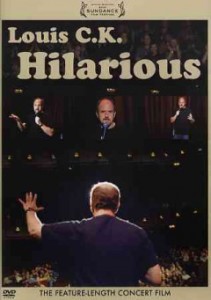
view/request
If you are easily offended by delicate or obscene subject matter, this 2010 concert film is, clearly, blatantly, spectacularly… not for you. Come to think of it, if you are offended by ANY words, in and of themselves, regardless of context, you may want to look elsewhere. It’s not that Louis is un-necessarily mean spirited or seeks to offend (well, except that he admittedly is and does, admitting at one point herein that shocking people makes him laugh) but he will leave many people squirming in their seats, probably laughing inside, but uncomfortable, to be sure. To those that love Louis C.K. , and I count myself strongly among them, his latest hour is the pinnacle of years of discipline and work on the road . It is the first Stand-Up film ever to be accepted at Sundance and the first stand-up comedy film in decades to show in theaters.
Unlike most working comics, Louie has been creating a completely new hour of stand-up every year, abandoning all older material, testing new routines every spring and summer in clubs and theaters before filming an hour special when his new hour is fully developed. Despite the obvious shock factor in many of the bits, what makes his comedy work so well is the surprising heart and thought that go into the writing, and the natural, “I just thought of this and I’m going to share it with you” delivery . When you are watching Louis perform at his best, you see the exasperated self-loathing character he describes and believe in it fully, to the point where you forget that he performs the act night in and night out, and it can be unsettling to see the same joke performed again elsewhere. Much of the best material he has used in his last few specials have been inspired by his role as a devoted father of two daughters and the experience of his recent divorce. When he delivers lines about the ridiculous anger and exasperation many parents feel but never openly express, it is always obvious and without question how much he loves his own children. While he brilliantly and savagely mocks the stupidity and spoiled impatience of modern day America, he saves his strongest contempt for himself.
The best stand-up is often that which lays bare the desperation and pain of our brief and ridiculous moment on earth and allows us to laugh at the most fragile and childish of our own instincts. At its best this film recalls some of the finest moments of his heroes, Pryor’s ability to make us laugh at his most painful moments and Carlin’s ability to dissect the absurdity of his time and make us see and laugh at ourselves. The film, however, is 100% Louie, and is the painfully funny work of a stand-up at the height of his powers.
Reviewed by Dylan
Tagged: Cell phones, Comedy, Divorce, Fatherhood, Obscenity, Parenting, Stupidity
Wheel of Time
by Werner Herzog
[DVD]
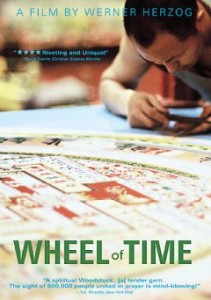
view/request
Werner Herzog, director of Fitzcarraldo, Aguirre: the Wrath of God and Stroszek, has almost become equally as famous for his non-fiction work in recent years thanks to the success of the fabulous Grizzly Man documentary. Forbes Library is fortunate to be receiving several of Herzog’s documentaries (many of which currently hard to find, out of print titles) through our acquisition of the Pleasant St. Video collection thanks to the kind donations from our patrons.
I first saw Wheel of Time at a Werner Herzog retrospective in Austin, TX. I must confess that I didn’t know much about the film or this German auteur at the time. I would soon receive a wonderful education by purchasing a pass to attend the rest of the festival and also borrowing everything I could find by the director at the video library where I was then employed.
The film chronicles a Buddhist pilgrimage to Bodh Gaya, India. At this destination, several artists create a giant, yet intricate, sand design or “sand mandala” (which is referred to as the wheel of time). The creation of the sand mandala is carefully constructed over a lengthy period of time and the viewer is constantly worried that it will not be completed by its deadline (or at least I was feeling tense). The stunning landscape along our travelers’ journey and the vibrant colors of the dyed sand are brilliantly captured by the film’s gorgeous cinematography. There is also a personal interview Herzog conducts with the Dalai Lama.
Wheel of Time, along with many of his documentaries, is certainly as interesting and entertaining as his classic fiction films. In both mediums, we are often supplied with adventure, drama, social commentary, humor and taken to exotic locales. Whether going up in a strange flying apparatus into a rainforest canopy, living in the jungle while filming, hauling a riverboat up a mountain, eating his own shoe, working with wild bears and collaborating with Klaus Kinski (!), Werner Herzog has managed to survive and also produce great art. It wasn’t until a 2006 BBC interview when his life became (arguably) most in danger when a sniper opened fire with an air rifle. After the shooting Herzog calmly commented, “it was not a significant bullet. I am not afraid.”
Reviewed by Jason
Tagged: Buddhism, Documentary, International
The Illusionist
by Sylvain Chomet
[DVD]
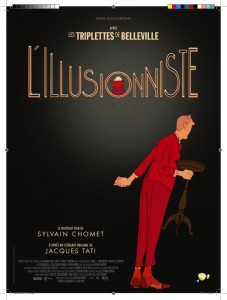
view/request
The Triplets of Belleville animator/director takes on an unrealized script of the late French comedian, writer and director Jacques Tati in the Illusionist. This remarkable, melancholic film features an animated Tati in the role of the magician named Tatcischeff (Tati’s actual last name) at a time when vaudeville performances are beginning to become a passé form of entertainment.
On a trip to Scotland for an appearance, Tatcischeff meets a young girl who winds up following him to London. The magician takes her under his care and winds up going broke funding her desire for expensive clothing. The two also come into contact with several eccentric and delightful characters surrounding the changing 1960’s entertainment industry.
What we have in the Illusionist is a funny, elegant and moving film which marries the essence of Jacques Tati’s brilliance and the stylish animation of Sylvain Chomet.
Reviewed by Jason
Tagged: Animation, Comedy, Feature film
Black Books
[DVD]

view/request
Irish comedian Dylan Moran stars in the BBC television series Black Books. The show was written and created by Moran and the folks who brought us Father Ted.
Bernard Black, a cranky and boozy book shop owner, wants absolutely nothing to do with his customers and does very little to aid his decaying store. He’s joined by his friend and neighboring shop employee, Fran and Manny, his hapless, but loveable (possibly unpaid) employee. We join these three on many madcap adventures and exercises in generally poor customer service. While a fair amount the gags fall under the customer/employee dynamic or displays of tremendous laziness, we also get a fair amount of surreal humor.
Reviewed by Jason
Tagged: British TV, Comedy
The Triplets of Belleville
[DVD]
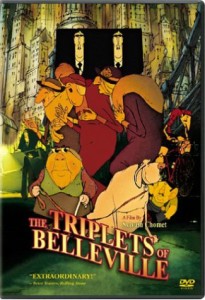
view/request
Sylvain Chomet’s feature-length animated film is like nothing you’ve ever seen. It’s weird, funny, sad, serious, lighthearted, suspenseful, perverse, sweet, surreal, retro, postmodern, and fantastic (in both senses of the word). There is virtually no dialogue, but there is music, adventure and character aplenty. The animation is hand-drawn and loaded with sophisticated detail. There are homages to Fred Astaire, Josephine Baker, Jacques Tati, the Andrews Sisters, and Django Reinhardt. The plot is quite satisfying, yet the style is the overwhelming story here. Despite the near-total absence of language, it could only be French. I have seen it three times so far and haven’t begun to get tired of it.
Reviewed by Faith
Tagged: Animation, Feature film, Foreign film
The story of Vernon and Irene Castle
[DVD]
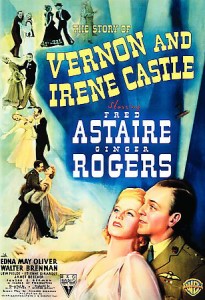
view/request
Based upon the true story of the celebrated husband and wife dancing team who popularized ballroom dance, this film is the most realistic, the most tragic, and the most touching of the Astaire-Rogers films. The film takes place in the years between 1911 and 1918, and the costumes and music are largely appropriate to that era. Most of the dance sequences emulate the Castle’s distinctive style—Astaire tap dances in only one number and Rogers not at all—and the musical numbers are fewer and more tightly integrated into the plot than in other Astaire films. Of course, the film still delivers what you expect from an Astaire-Rogers collaboration: Astaire is charming, the music is great, the dancing better, and the two stars may have better on-screen chemistry in this film than in any other.
Reviewed by Ben
Tagged: Comedy, Dance, Drama, Feature film
The Purple Rose of Cairo
[DVD]
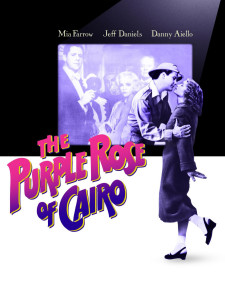
view/request
“You make love without fading out?” – Tom Baxter
The Purple Rose of Cairo is possibly my favorite Woody Allen film of all time… or perhaps tied with a couple other of his classics. In it we have some of his sharpest comedic screenwriting and a few concepts that will keep philosophy 101 students in discussion for decades to come.
It stars Mia Farrow as Cecilia, a woman struggling to support herself and her abusive, gambling and out of work husband (played by Danny Aiello) during the great depression. Her only escape from this drudgery is regular visits to the local cinema. When the lights dim, she gets whisked away in stories of adventure, romance and carefree living.
She particularly is enamored with the film the Purple Rose of Cairo (the film within our film!). Cecilia makes repeated trips to catch the Purple Rose and watches the story of bubbly society folk on an Egyptian expedition. After several viewings, she starts to notice slight inconsistencies with one of the character’s performance. Tom Baxter, played by Jeff Daniels, seems to be losing his timing and is possibly looking off into the audience. Eventually, he breaks character and talks to Cecilia from the screen. She nervously replies and Baxter walks out of the film and materializes in the theater.
The two dash off in a heap of commotion and the ex-film character appears to be the ideal romantic partner despite naïveté in real world dealings. His knowledge base consists of what was written for his character. For example, when dining, the couple are embarrassed to discover that Baxter’s cash supply is simply prop money.
Eventually, a surreal love triangle… or better yet, love square forms. When Gil Shepherd (also played by Jeff Daniels), the actor who portrayed Baxter, discovers that his character has left the film, he heads to New Jersey to convince his creation to re-enter The Purple Rose of Cairo. Whilst attempting to salvage his reputation and make everything go back to normal, Shepherd then falls for our leading lady. Does Cecilia leave her husband? Does she run off with the brave and compassionate, but fictional Tom Baxter? Or does she chose Gil Shepherd, the dashing and vain movie star?
Reviewed by Jason
Tagged: Comedy, Feature film
The Red Shoes
[DVD]
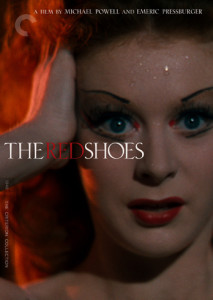
view/request
The Red Shoes is a visually stunning dramatic work about a ballet company led by the ruthless and contentious, but often charming director Boris Lermontov. Lermontov discovers dancer Vicky Page (portrayed by famed English ballet star Moira Shearer) at a society party and realizes her unparalleled potential. Before signing her to his company she must decide what role dancing plays in her life. Is it a passion she pursues or shall it consume her entirely? Can an artist love anything or anyone more than their craft? These conflicts becomes the underlying theme of the picture.
The Hans Christian Andersen story of The Red Shoes is the source in which the main ballet within the film is based. Instead of just viewing the performance from the theater audience’s perspective, Powell and Pressburger take the camera’s inside the action for a breathtaking, 17-minute sequence. We follow Page closely via dolly shots through various enormous, painted set pieces, close-ups of dancers movements and expressions and rich colored lights. The co-directors also chose to allow fantasy to be a part of the stage presentation as well with tasteful in camera visual effects.
The Red Shoes, which melodrama and beauty reach unbelievable heights, is a remarkable achievement in cinema.
Reviewed by Jason
Tagged: Ballet, Drama, Feature film
Head
by Bob Rafelson
[DVD]
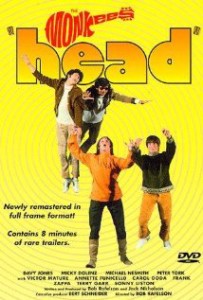
view/request
Head is a psychedelic, non-linear motion picture starring… THE MONKEES. While not participating in a traditional narrative, the film retains a cyclical structure. Cyclical, in this instance, by that one can take nearly any scene, rearrange it and the action will still relate and have meaning in its new place. Bob Rafelson, a co-creator of the Monkees television series, made his feature directorial debut with 1968’s Head. He co-wrote the film with the then obscure Roger Corman school B-movie actor Jack Nicholson.
Rafelson and Nicholson sought to tell the Monkees story and the complexities of instant fame in an abstract fashion while also exploiting as many genres as possible. It poses the question, “well, what is Head?” A musical? A western? A horror film? A comedy? A boxing story? A Vietnam war protest? A sprawling adventure film? It’s safe to say these are all correct answers. The director uses esoteric dialog and cutting edge technology (i.e. the process of coloring film… which was essentially only explored in avante-guarde cinema up until this time) to collect these disparate elements and house them in a single story.
What also works in this film’s favor is that we have a collection of some of the Monkees best recorded material. Mickey Dolenz sings two lazing and beautiful Carole King compositions along with the Eastern flavored “Can You Dig It”, a song by Monkey Peter Tork. Peter’s other writing credit comes with the groovy freakout “Long Title: Do I Have to Do This All Over Again”. Davy Jones performs a dance scene with Toni Basil while singing Harry Nilsson’s Tin Pan Alley inspired “Daddy’s Song”. Michael Nesmith writes and sings “Circle Sky”, what we shall only consider as a psychedelic, ramshackle ho-down.
Although, in 1968 the film proved to be an immense commercial failure, Head has become a cult classic and an excellent artifact in the colored history of the Monkees. Rafelson continued his maverick approach to cinema and is now considered one of the most revered directors and producers of the “New Hollywood” generation.
Reviewed by Jason
Tagged: Comedy, Feature film, Musicals
Two Escobars
[DVD]

view/request
This riveting documentary film was made by Northampton natives Jeff and Michael Zimbalist as part of the excellent ESPN 30 for 30 series. It examines a harrowing period in Colombia’s history when rival drug cartels were warring in the streets and the national soccer team set out to win the world cup and by extension, create a new positive image for their country. The Two Escobars of the title are Andres Escobar, the softspoken but inspiring captain of the National Team, and Pablo Escobar, who was a notorious cartel leader and brutal drug baron, but also a team owner and folk hero to many poor people in Colombia. The documentary takes a clear eyed look at a period of Colombian soccer and society which stretched from the height of the phenomenon known as “Narco-Soccer” through their ignominious and ultimately tragic loss in the first round of the 1994 World Cup. Like many of the 30 for 30 series filmmakers, the directors succeed in showing the importance and influence of sport on society as a whole, how it reflects and is influenced by the best and worst aspects of our culture. As a result the film appeals to viewers who are not die-hard sports fans, ‘soccer’ fans or familiar with World Cup Football. One of the best of the ESPN 30 for 30 series and best documentaries of 2010, it was an Official Selection at the Cannes, Tribeca and Los Angeles Film Festivals.
Reviewed by Dylan
Tagged: Colombia, Documentary, Soccer












